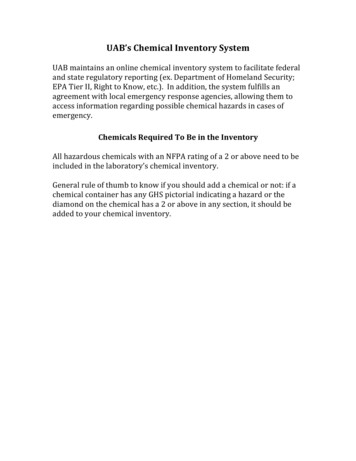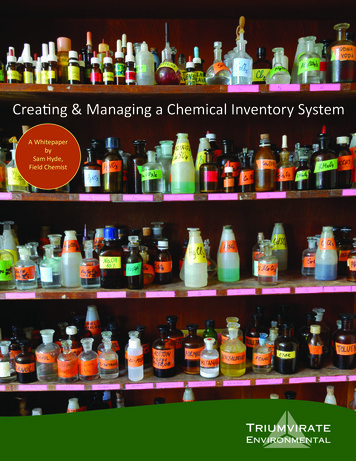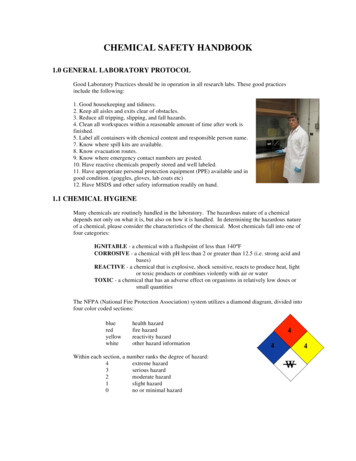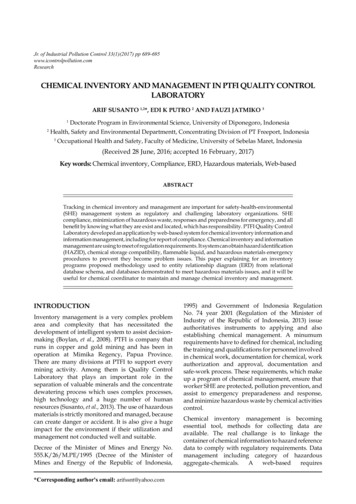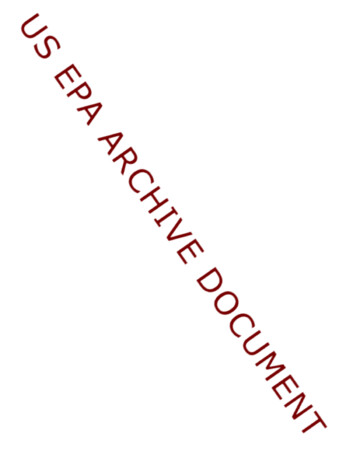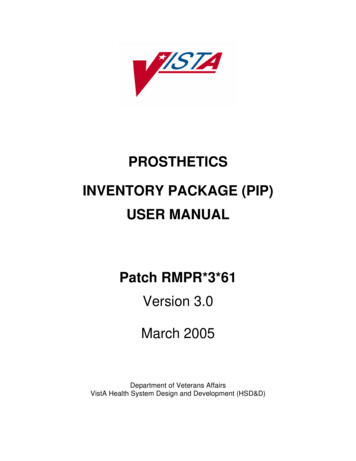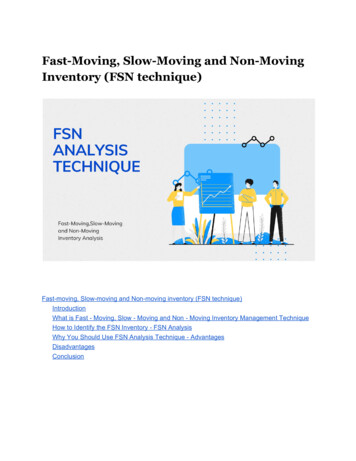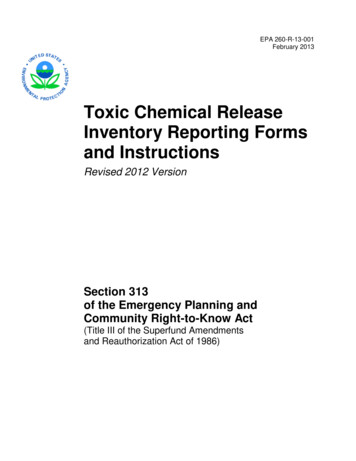
Transcription
EPA 260-R-13-001February 2013Toxic Chemical ReleaseInventory Reporting Formsand InstructionsRevised 2012 VersionSection 313of the Emergency Planning andCommunity Right-to-Know Act(Title III of the Superfund Amendmentsand Reauthorization Act of 1986)
This Page Intentionally Left Blank
Table of ContentsTable of ContentsList of Acronyms . iImportant Information for Reporting Year 2012 . iiNew Information for Reporting Year 2012 . iiOther Important Information for Reporting Year 2012 . iiiTRI-MEweb Reporting Year 2012 version. ivA.General Information . 1A.1Who Must Report . 1A.2How to Submit Forms . 1A.2.a.How to Submit Form R(s) and/or Form A(s) Certification Statement Electronically toEPA via the Central Data Exchange (Using the TRI-MEweb Application) . 1How to Submit Paper Form R (s) and/or Form A Certification Statement(s). 4A.2.bA.3Trade Secret Claims . 5A.4Recordkeeping . 5A.5How to Revise, Withdraw or Cancel TRI Data. 6A.5.1Revising TRI Data. 6A.5.2Withdrawing TRI Data . 8A.5.3Canceling a TRI Submission . 9A.6When the TRI Report Must Be Submitted. 10A.7How to Obtain the TRI Reporting Forms . 10B.How to Determine if Your Facility Must Submit a Form R or Is Eligible to Use Form A . 11B.1Full-Time Employee Determination. 11B.2Primary NAICS Code Determination . 11B.2.a.Auxiliary Facilities . 14B.2.b.Multi-establishment Facilities . 14Property Owners . 15B.2.c.B.3Activity Determination . 15Definitions of Manufacture, Process, and Otherwise Use . 15B.3.a.B.3.b. . Persistent Bioaccumulative Toxic (PBT) Chemicals and Chemical Categories Overview. 18B.3.c.Activity Exemptions . 19B.4Threshold Determinations . 25How to Determine if Your Facility Has Exceeded Thresholds . 26B.4.a.Threshold Determinations for On-Site Reuse Operations . 27B.4.b.B.4.c.Threshold Determinations for Ammonia . 27B.4.d.Threshold Determinations for Chemical Categories . 28B.4.eThreshold Determination for Persistent Bioaccumulative Toxic (PBT) Chemicals . 29B.4.f.Mixtures and Other Trade Name Products . 29B.5Release and Other Waste Management Determinations for Metals, Metal Category Compounds,and Nitrate Compounds . 30C.Instructions for Completing TRI Form R . 36Part I. Facility Identification Information . 36Section 1. Reporting Year . 36Section 2. Trade Secret Information . 36Section 3. Certification . 36Section 4. Facility Identification . 36Section 5. Parent Company Information. 39Part II. Chemical Specific Information . 40Section 1. EPCRA Section 313 Chemical Identity. 40Section 2. Mixture Component Identity. 41Section 3. Activities and Uses of the EPCRA Section 313 Chemical at the Facility . 41Toxics Release Inventory Reporting Forms and InstructionsTOC-1
Table of ContentsSection 4. Maximum Amount of the EPCRA Section 313 Chemical On-site at Any Time during theCalendar Year. 44Section 5. Quantity of the Toxic Chemical Entering Each Environmental Medium On-site . 45Section 6. Transfer(s) of the Toxic Chemical in Wastes to Off-Site Locations . 52Section 7. On-Site Waste Treatment, Energy Recovery, and Recycling Methods . 61Section 8. Disposal or Other Releases, Source Reduction, and Recycling Activities . 68D.Instructions for Completing Form R Schedule 1 (Dioxin and Dioxin-like Compounds) . 82D.1What is the Form R Schedule 1? . 82D.2Who is required to file a Form R Schedule 1? . 82D.3What information is reported on the Form R Schedule 1? . 82E.Facility Eligibility Determination for Alternate Threshold and for Reporting on TRI FormA Certification Statement . 85E.1Alternate Threshold . 85E.2What is the Form A Certification Statement? . 85E.3What Is the Annual Reportable Amount (ARA)? . 85E.4Recordkeeping . 86Multi-establishment Facilities . 86E.5E.6Trade Secrets. 86Metals and Metal Category Compounds . 86E.7F.Instructions for Completing TRI Form A Certification Statement . 88Part I. Facility Identification Information . 88Section 1. Reporting Year . 88Section 2. Trade Secret Information . 88Section 3. Certification . 88Section 4. Facility Identification . 89Section 5. Parent Company Information . 91Part II. Chemical Identification . 92Section 1. Toxic Chemical Identity . 92Section 2. Mixture Component Identity. 93Index . 94Toxics Release Inventory Reporting Forms and InstructionsTOC-2
Table of ContentsExamplesExample 1:Example 2:Example 3:Example 4:Example 5:Example 6:Example 7:Example 8:Example 9:Example 10:Example 11:Example 12:Example 13:Example 14:Example 15:Example 16:Example 17:Example 18:Example 19:Example 20:Example 21:Example 22:Example 23:Example 24:Example 25:Example 26:Example 27:Coincidental Manufacture. 16Typical Process and Manufacture Activities. 17Typical Otherwise Use Activities. 17Articles Exemption . 20De Minimis Applications to Process and Otherwise Use Scenarios for Non-PBTChemicals . 22Concentration Ranges Straddling the De Minimis Value . 23De Minimis Application in the Manufacture of a Toxic Chemical in a Mixture. 24Coal mining extraction activities . 25Mixtures and Other Trade Name Products . 31Mixture Containing Unidentified EPCRA Section 313 Chemical . 41Manufacturing and Processing Activities of EPCRA Section 313 Chemicals . 44Reporting Dioxins and Dioxin-Like Compounds. 46Stormwater Runoff . 52Container Residue . 56Reporting Metals and Metal Category Compounds that are sent Off-site . 57Calculating Releases and Other Waste Management Quantities . 63On-Site Waste Treatment. 67Reporting On-Site Energy Recovery . 68Reporting Future Estimates. 70Avoiding Double-Counting Quantities in Sections 8.1 through 8.7. 72Quantity Released to the Environment as a Result of Remedial Actions, CatastrophicEvents, or One-Time Events Not Associated with Production Processes. . 73Determining a Production Ratio. 75Determining an Activity Index. 75“NA” is Entered as the Production Ratio or Activity Index . 75Determining the Production Ratio Based on a Weighted Average . 76Source Reduction . 79Green Chemistry . 80FiguresFigure 1.Figure 2.Figure 3A.Figure 3B.Figure 3C.Figure 3D.Figure 4.TRI-MEweb’s Preparation, Transmission, Certification and Submission Steps. 2EPCRA Section 313 Reporting Decision Diagram . 13EPCRA Section 313 Non-PBT Chemical Reporting Threshold Worksheet. 32EPCRA Section 313 Reporting Threshold Worksheet for PBT Chemicals with 100 PoundThresholds. 33EPCRA Section 313 Reporting Threshold Worksheet for PBT Chemicals with 10 PoundThreshold . 34EPCRA Section 313 Reporting Threshold Worksheet for Dioxin and Dioxin-LikeCompounds Chemical Category. 35Reporting EPCRA Section 313 Chemicals . 43Toxics Release Inventory Reporting Forms and InstructionsTOC-3
Table of ContentsFigure 5.Figure 6.Figure 7.Hypothetical Section 6.2 Completed for Two Off-Site Locations . 60Hypothetical Section 7A . 64Hypothetical Form R, Section 5.1 and Form R Schedule 1, Section 5.1 . 83TablesTable ITable IITable IIITable IVTable VNAICS Codes.I-1EPCRA Section 313 Chemical for Reporting Year 2012 (including Toxic ChemicalCategories) . II-1State Abbreviations . III-1Federal Information Processing Standards (FIPS) Country Codes . IV-1Bureau of Indian Affairs (BIA) Tribal Codes . V-1AppendicesAppendix AAppendix BAppendix CAppendix DAppendix EAppendix FAppendix GAppendix HAppendix IFederal Facility Reporting Information . A-1Reporting Codes for EPA Form R and Instructions for Reporting Metals . B-1Facility Data Profiles and Common Errors in Completing Form R Reports and Form ACertification Statements. C-1Supplier Notification Requirements . D-1TRI State and Tribal Contacts .E-1TRI Regional Contacts . F-1Other Relevant Section 313 Materials . G-1Guidance Documents. H-1Questions and Answers Regarding Facility Identification Information .I-1Toxics Release Inventory Reporting Forms and InstructionsTOC-4
This Page Intentionally Left BlankToxics Release Inventory Reporting Forms and Instructions
List of AcronymsList of YSBREFASICTDXTRITRIFIDTRIPSUICUSCVOCsAnnual Reportable AmountBureau of Indian AffairsChemical Abstract ServicesConfidential Business InformationCentral Data ExchangeComprehensive Environmental Response, Compensation, and Liability ActCode of Federal RegulationsDun & BradstreetData Processing CenterData Quality AlertEthylenebisdithiocarbamic Acid, Salts and EstersElectronic Facility Data ProfileEnvironmental Protection AgencyEmergency Planning and Community Right to Know ActElectronic Signature AgreementFacility Data ProfileFederal Information Processing StandardFederal RegisterGovernment-Owned, Contractor-OperatedInternational Agency for Research and CancerInformation Collection RequestMaterial Safety Data SheetsNot ApplicableNon-Technical Data ChangesNorth American Industry Classification SystemNotice of Non-ComplianceNotice of Significant ErrorNotice of Technical ErrorsNational Pollutant Discharge Elimination SystemNational Toxicology ProgramOffice of Management and BudgetOccupational Safety and Health ActPollution PreventionPolycyclic Aromatic CompoundsPolybrominated BiphenylsPersistent Bioaccumulative ToxicPolychlorinated BiphenylsPublicly Owned Treatment WorksPollution Prevention ActResource Conservation and Recovery ActReporting YearSmall Business Regulatory Enforcement Fairness ActStandard Industrial ClassificationTRI Data ExchangeToxics Release InventoryToxics Release Inventory Facility Identification NumberToxics Release Inventory Processing SystemUnderground Injection ControlUnited States CodeVolatile Organic CompoundsToxics Release Inventory Reporting Forms and Instructionsi
Important Information for Reporting Year 2012the greatest number of source RI/P2.Important Information forReporting Year 2012 New Information for Reporting Year2012Please note that this 2012 version of the ToxicsRelease Inventory (TRI) Reporting Forms andInstructions document supersedes previous versionsof the document. Administrative Stay Lifted forHydrogen Sulfide (H2S) ReportingTRIA Federal Register notice was issued onMonday, October 17, 2011 (76 FR 64022)announcing that EPA is lifting theAdministrative Stay of the EPCRA section 313toxic chemical release reporting requirements ofhydrogen sulfide - H2S - (CAS No. 7783-06-4).Reporting for H2S is required for RY 2012reporting (i.e., for Form R and Form ACertification Statements that are due to theAgency at midnight on July 1, 2013). For moreinformation about the lifting of theadministrative stay for H2S, fide/indexf.html. New Green Chemistry Source ReductionCodesNew source reduction codes that describe greenchemistry practices have been added to the listof selections available for completing Section8.10. New in TRI-MEweb for RY 2012oEPA has developed a new certificationcomponentwithin the TRI-MEwebapplication that will allow a facility toprepare any reporting year TRI Form R/Aand transition directly into the certificationprocess without leaving the TRI-MEwebapplication.oTRI Reporting for Facilities Located inIndian country and Clarification ofAdditional Opportunities Available to TribalGovernment under the TRI ProgramAn ESA form is a statement that declaresthat the registrant understands that anyelectronic signature executed with theelectronic signature device is as legallybinding as a handwritten signature and isrequired by EPA before any certifyingofficial can certify and submit a TRI formcreated in TRI-MEweb.Pollution PreventionIn order to promote pollution prevention, EPAhas increased the prominence and accessibilityof the pollution prevention information reportedin Sections 8.10 and 8.11 of the Form R. Forexample, the 2011 TRI National Analysishighlighted the parent companies that reportedNew Real-Time Electronic SignatureAgreement (ESA) Approval Option forNew Certifying OfficialsFor this reporting year, EPA hasimplemented an alternative method forcertifying officials to apply for and processan ESA in real-time using a is. Upon registering for a newCDX account at https://cdx.epa.gov, allnewly appointed certifying officials will beprompted to consider using this third-partyverification and authentication service toobtain their ESA approval in real-timeinstead of processing the traditional paperESA form for EPA approval.EPA finalized a rule on April 19, 2012 (77 FR23409) which requires each facility located inIndian country to submit TRI reports to EPAand the appropriate tribe, rather than to the statein which the facility is geographically located.The final rule also provides the tribalchairperson or equivalent elected official of atribe with the same opportunities as thegovernor of a state with regard to TRI-relatedrequests and petitions. The rule requirements areapplicable for reporting year 2012 for TRIreports due to the Agency by July 1, 2013. New Certification Process in TRI-MEwebfor RY 2012 ReportingoTRI-MEwebUpgradesPollutionPreventionEPA has made several changes to TRIMEweb to facilitate completion of thePollution Prevention section of the Form R(Section 8). For example, TRI-MEweb nowToxics Release Inventory Reporting Forms and Instructionsii
Important Information for Reporting Year 2012provides a Production Ratio/Activity IndexWizard to automatically calculate yourProduction Ratio/Activity Index (Section8.9). TRI-MEweb also includes new tipsand guidance for completing Sections 8.98.11 and allows the user to submitadditional information about specific entriesin Sections 8.9-8.10 if desired. (Thisinformation is then included in Sections8.11 or 9.1 as appropriate.)Other Important Information forReporting Year 2012EPA’s Audit Policy. If you discover your facility isor may have been in violation of Section 313 ofEPCRA (TRI Reporting), please refer to EPA’sPolicy entitled, “Incentives for Self-Policing:Discovery, Disclosure, Correction, and Preventionof Violations” (Audit Policy), 65 FR 19618, April11, 2000. You may qualify for having all gravitybased penalties waived if your facility meets all nine(9) conditions of the Audit Policy. For moreinformation on EPA’s Audit Policy, see theAgency’s uditing/auditpolicy.html.EPA Enforcement Response Policy for TRIRevisions. On September 26, 1991, EPA publishedin the Federal Register, a “Notice RegardingRevisions to Toxic Chemical Release InventoryReporting Forms under Section 313 of theEmergency Planning and Community Right-toKnow Act of 1986” (56 FR 48795-03). Section Vof the Notice refers to the Agency’s Enforcementand Penalties policy regarding Form R errors:Facilities are reminded that there is a legalobligation to file an accurate and complete Form Rreport for each chemical by July 1 each year. EPAmay take enforcement action and assess civiladministrative penalties regarding corrections toerrors in Form R reports that are not changes basedon previously unavailable information or procedureswhich improve the accuracy of the data initiallyreported. The kinds of errors which may result inenforcement and in penalties include but are notlimited to the following: (1) Errors caused by notusing the most readily available information, forexample, not using monitoring data collected forcompliance with other regulations in calculatingreleases; (2) omitting a major source of emissions;(3) a mathematical or transcription or typographicalerror which seriously compromises the accuracy ofthe information, and; (4) other errors whichseriously affect the utility of the data, particularlyerrors in release reporting for which the facility hasno records showing the derivation of the releasecalculation, and cannot provide a sufficientexplanation of the report.EPA’s Small Business Compliance Policy. If youhave 100 or fewer employees and discover that yourfacility is or may have been in violation of Section313 of EPCRA (TRI Reporting), please refer toEPA’s Small Business Compliance Policy. EPA willeliminate or significantly reduce penalties for smallbusinesses that meet the conditions of the Policy,including voluntarily discovering violations andpromptly disclosing and correcting them. ThisPolicy implements Section 223 of the SmallBusiness Regulatory Enforcement Fairness Act(SBREFA) of 1996. For more information, see theAgency’s mallbusiness/index.html.Parent Company Information. In past years, theAgency found that many facilities report inaccurateparent companies and/or Dun and Bradstreetnumbers in Sections 4 and 5 of the TRI reportingforms. All facilities should verify the accuracy offacility and parent company information (e.g.,DUNS number, parent company name). Relatedquestions and answers are provided in Appendix I.Please note that beginning in Reporting Year 2009,EPA started to pre-load standardized parentcompany names into the TRI-MEweb software thatwere researched from the prior year submission.This step was taken to improve the accuracy ofparent company names as well as create a standardformat for the names themselves. For example, onlycapital letters are used and all periods areeliminated from the parent names. In addition,standardized abbreviations are now used forcommon terms found in parent names such as ‘COfor Company’ and ‘INC for Incorporated.’ Moredetailed instructions appear in the Parent Companyname sections of TRI-MEweb.For facilities still using paper TRI forms to report, adetailed listing of Parent Company names isprovided at:http://www.epa.gov/tri/report/index.htm.Toxics Release Inventory Reporting Forms and Instructionsiii
Important Information for Reporting Year 2012A. To verify the accuracy of your facility andparent company Dun and Bradstreet number andname, as required in Section 5 of both Form Rand Form A, go to:https://www.dnb.com/product/dlw/form cc4.htm or call 1-888-814-1435 to verify yourinformation. Callers to the toll free phonenumber should understand that the Dun andBradstreet support representatives will need toverify that callers requesting the DUNSnumbers are agents of the business. Dun andBradstreetrecommendsknowingbasicinformation such as when the businessoriginated, officer names, and the name,address, and phone number for the facility.B. Facilities reporting to TRI should also makesure they are providing the parent companyname and Dun and Bradstreet number as ofDecember 31st of the current reporting year.TRI-MEweb Reporting Year 2012versionThe TRI-MEweb application helps facilities fulfilltheir Emergency Planning and Community Right-toKnow (EPCRA) Section 313 and PollutionPrevention Act (PPA) Section 6607 obligations.TRI-MEweb is an interactive, intelligent, userfriendly web-based application tool that guidesfacilities through the TRI reporting experience. Byleading prospective reporters through a series oflogicallyorderedquestions,TRI-MEwebstreamlines the analysis needed to determine if auser must complete a Form R Report or if they meetthe thresholds that allow them to use the Form ACertification Statement for a particular chemical.The TRI-MEweb software provides the user withguidance for each data element on the reportingForm R and Form A Certification Statement. TRIMEweb will check the data on the form for commonerrors and then prepare it for electronic transmissionto be certified in CDX (see Figure 1 on page 2 for aflow diagram of the TRI-MEweb reporting process).All of the information contained in this RY 2012Reporting Forms and Instructions manual iscontained within the TRI-MEweb application.EPA strongly recommends the use of TRIMEweb to submit information to the TRIprogram. However, if you plan to submit hardcopy forms for current year and prior year forms(RY 2011 and RY 2012), EPA provideselectronically fillable TRI forms at:http://www.epa.gov/tri/reporting materials/forms/that can be completed using a computer and thenprinted, signed, and mailed.EPA will accept only TRI-MEweb or papersubmissions for RY 2012. The following arereasons why you should use TRI-MEweb in RY2012: TRI-MEweb will guide reporting facilitiesthrough the RY 2012 changes to the reportingrequirements described earlier in this section. A Web-enabled threshold determination tool isavailable on the TRI website at:http://www.epa.gov/tri/reporting materials/threshold/ to help facilities determine whether theyneed to report to TRI. The threshold tool isuseful in determining whether a facility meetsall three threshold indices: number ofemployees, covered industry sector andchemical-specific thresholds.Toxics Release Inventory Reporting Forms and Instructions
Section 5. Quantity of the Toxic Chemical Entering Each Environmental Medium On-site . 45 Section 6. Transfer(s) of the Toxic Chemical in Wastes to Off-Site Locations . 52 Section 7. On-Site Waste Treatment, Energy Recovery, and Recycling Methods. 61 Section 8.
